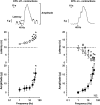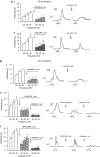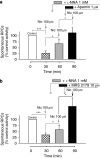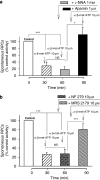Effects of excitatory and inhibitory neurotransmission on motor patterns of human sigmoid colon in vitro
- PMID: 18846038
- PMCID: PMC2597251
- DOI: 10.1038/bjp.2008.332
Effects of excitatory and inhibitory neurotransmission on motor patterns of human sigmoid colon in vitro
Abstract
Background and purpose: To characterize the in vitro motor patterns and the neurotransmitters released by enteric motor neurons (EMNs) in the human sigmoid colon.
Experimental approach: Sigmoid circular strips were studied in organ baths. EMNs were stimulated by electrical field stimulation (EFS) and through nicotinic ACh receptors.
Key results: Strips developed weak spontaneous rhythmic contractions (3.67+/-0.49 g, 2.54+/-0.15 min) unaffected by the neurotoxin tetrodotoxin (TTX; 1 microM). EFS induced strong contractions during (on, 56%) or after electrical stimulus (off, 44%), both abolished by TTX. Nicotine (1-100 microM) inhibited spontaneous contractions. Latency of off-contractions and nicotine responses were reduced by N(G)-nitro-L-arginine (1 mM) and blocked after further addition of apamin (1 microM) or the P2Y(1) receptor antagonist MRS 2179 (10 microM) and were unaffected by the P2X antagonist NF279 (10 microM) or alpha-chymotrypsin (10 U mL(-1)). Amplitude of on- and off-contractions was reduced by atropine (1 microM) and the selective NK(2) receptor antagonist Bz-Ala-Ala-D-Trp-Phe-D-Pro-Pro-Nle-NH(2) (1 microM). MRS 2179 reduced the amplitude of EFS on- and off-contractions without altering direct muscular contractions induced by ACh (1 nM-1 mM) or substance P (1 nM-10 microM).
Conclusions and implications: Latency of EFS-induced off-contractions and inhibition of spontaneous motility by nicotine are caused by stimulation of inhibitory EMNs coreleasing NO and a purine acting at muscular P2Y(1) receptors through apamin-sensitive K(+) channels. EFS-induced on- and off-contractions are caused by stimulation of excitatory EMNs coreleasing ACh and tachykinins acting on muscular muscarinic and NK(2) receptors. Prejunctional P2Y(1) receptors might modulate the activity of excitatory EMNs. P2Y(1) and NK(2) receptors might be therapeutic targets for colonic motor disorders.
Figures










References
-
- Anand N, Paterson WG. Role of nitric oxide in esophageal peristalsis. Am J Physiol. 1994;266:G123–G131. - PubMed
-
- Boeckxstaens GE, Pelckmans PA, Herman AG, Van Maercke YM. Involvement of nitric oxide in the inhibitory innervation of the human isolated colon. Gastroenterology. 1993;104:690–697. - PubMed
-
- Bultmann R, Dudeck O, Starke K. Evaluation of P2-purinoceptor antagonists at two relaxation-mediating P2-purinoceptors in guinea-pig taenia coli. Naunyn Schmiedebergs Arch Pharmacol. 1996;353:445–451. - PubMed
Publication types
MeSH terms
Substances
LinkOut - more resources
Full Text Sources

